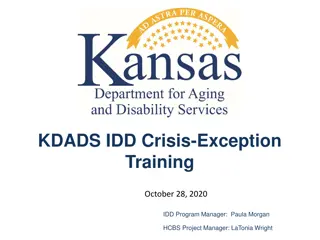Understanding Exception Handling in VB.NET
Learn about exception handling in VB.NET using the built-in Exception class, Try-Catch structure, and handling different types of errors gracefully. Dive into examples and best practices for effective error management in your VB.NET programs.
Download Presentation

Please find below an Image/Link to download the presentation.
The content on the website is provided AS IS for your information and personal use only. It may not be sold, licensed, or shared on other websites without obtaining consent from the author. Download presentation by click this link. If you encounter any issues during the download, it is possible that the publisher has removed the file from their server.
E N D
Presentation Transcript
Exception Handling VB.NET has an inbuilt class that deals with errors. The Class is called Exception. When an exception error is found, an Exception object is created. The coding structure VB.NET uses to deal with such Exceptions is called the Try Catch structure. In the coding area for your button, type the word Try. Then hit the return key on your keyboard. VB.NET completes the rest of the structure for you: Try Catch ex As Exception End Try
Exception Handling The Try word means Try to execute this code . The Catch word means Catch any errors here . The ex is a variable, and the type of variable is an Exception object. When you run your program, VB will Try to execute any code in the Try part. If everything goes well, then it skips the Catch part. However, if an error occurs, VB.NET jumps straight to Catch. Because ex is an object variable, it now has its own Properties and methods. One of these is the Message property
Example Dim x As Integer = 5 Dim y As Integer = 0 Dim z As Integer Try z = x / y MsgBox(z) Catch ex As Exception MsgBox(ex.Message) End Try
Exception Handling FileName = C:\test10.txt fs = new FileStream(FileName, FileMode.Open, FileAccess.Read)
Exception Handling The point about this new message box is that it will not crash your program. You have handled the Exception, and displayed an appropriate message for the user. If you know the kind of error that a program might throw, you can get what Type it is from the Error message box you saw earlier. This one:
Click the View Details links under Actions to see the following:
Exception Handling The first line tells us the Type of Exception it is: System.IO.FileNotFoundException You can add this directly to the catch part. Previously, you were just catching any error that might be thrown: Catch ex As Exception But if you know a file not found error might be thrown, you can add that to the Catch line, instead of Exception: Catch ex As System.IO.FileNotFoundException You can keep the Exception line as well. (You can have as many Catch parts as you want.) This will Catch any other errors that may occur: Try fs = new FileStream(FileName, FileMode.Open, FileAccess.Read) Catch ex As System.IO.FileNotFoundException MsgBox( Can t find this file ) Catch ex As Exception MsgBox(ex.Message) End Try
Exception Handling There is one last part of the Try Catch Statement that VB.NET doesn t add for you Finally: Try Catch ex As Exception Finally End Try The Finally part is always executed, whether an error occurs or not. You typically add a Finally part to perform any cleanup operations that are needed. For example, you may have opened a file before going into a Try Catch Statement. If an error occurs, the file will still be open. Whether an error occurs or not, you still need to close the file. You can do that in the Finally part.























